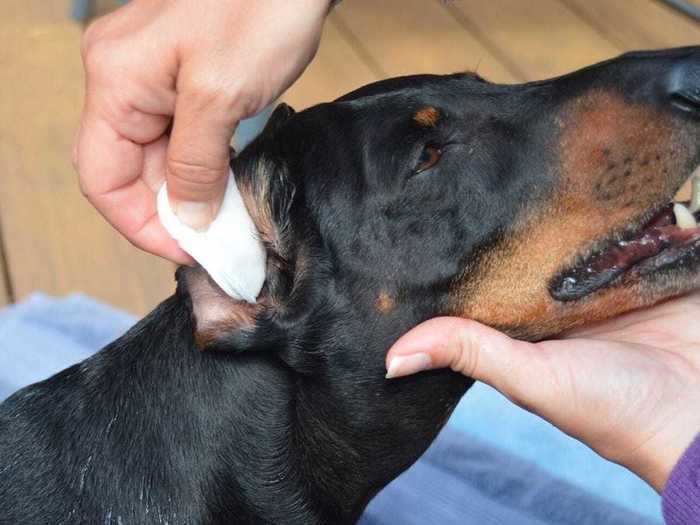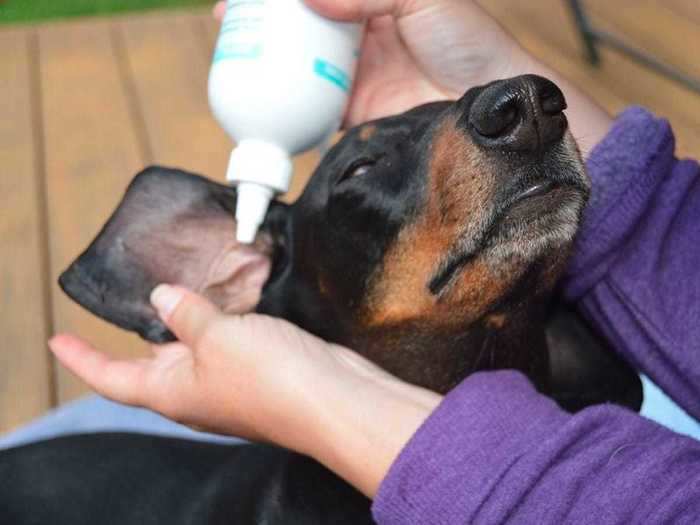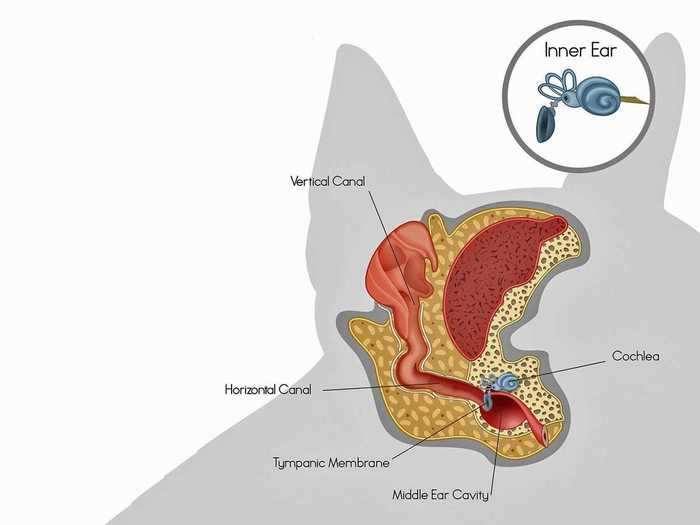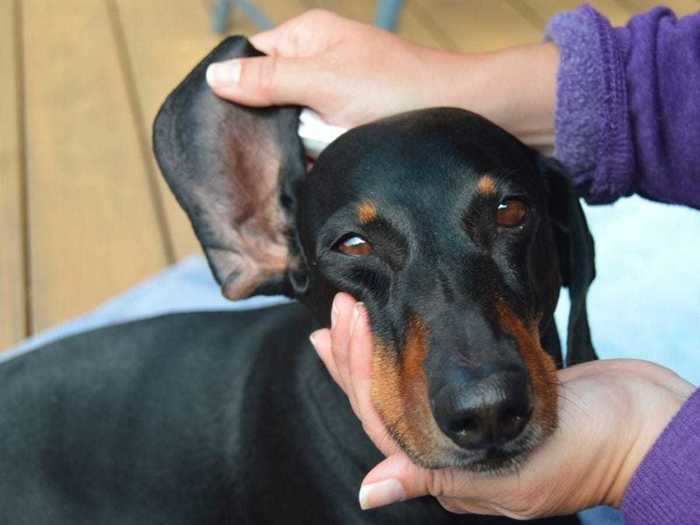When you buy through our links, we may earn money from our affiliate partners. Learn more.
- Keeping your dog's ears clean is an important part of their grooming routine, especially if they are prone to ear infections.
- Here's how to clean your dog's ears along with the tools you need to make it a successful experience.
- The eardrum is very fragile and can be damaged by ear disease or during cleaning, so it's important to exercise caution while cleaning and follow these steps precisely.
- Always consult your veterinarian if your dog shows signs of an ear infection, which may include shaking their head, holding it to one side, odor, or signs of pain.
- For more grooming products, see the best dog nail clippers, dental products, and brushes.
Some dogs never or rarely need to have their ears cleaned. For other dogs, the external ear canal may accumulate wax and debris, so they may benefit from regular at-home ear cleaning. This could depend on their breed (ear shape, presence of hair in the ear canal), lifestyle (swimming), or medical conditions (allergies). Your veterinarian can advise you as to whether or not it's necessary for your dog.
My dachshund Walter has long hound ears and an even longer ear canal where debris accumulates, so I clean his ears once a week. Based on my experience working as a certified veterinary technician at a clinic and teaching clients how to clean a dog's ears, you don't need a lot of tools to do this at home. Many of the items are human grooming tools, including balls of cotton and tissues. Your veterinarian or tech can help you select an ear cleaner that is right for your dog.
If your dog has painful ears or strongly resists routine ear cleanings, your veterinarian can also administer a sedative or a short-acting general anesthetic and do an ear cleaning at their clinic. With that in mind, many dogs are okay with their owners cleaning their healthy ears between vet visits. "Most dogs can learn to tolerate this with patience and treats," said Dr. Brian Collins, faculty veterinarian at Cornell University College of Veterinary Medicine.
Although routine at-home cleanings can support your dog's ear health, it's important to consult your veterinarian if there are any signs of infection. "If you notice your dog shaking her head, holding her head to one side, or if you notice an odd odor or signs of pain, have your veterinarian examine her as soon as possible," said Collins. A veterinarian will examine your dog's ears, take a sample of discharge for further evaluation, prescribe any necessary medications, and potentially do an in-office cleaning.
Here's how to clean your dog's ears at home:Read the original article on
Insider
How to wipe your dog's ears
Christine Caplan/INSIDER
- Balls of cotton or cotton rounds can be used to gently wipe the wax from the external ear canal.
- It's important to only remove debris that is visible in the vertical canal so that it isn't pushed deeper into the horizontal canal leading to the eardrum, as shown in the diagram. It also isn't necessary to get the ear perfectly clean in a single session.
- Once the ear canal is clean, the canal should be carefully dried with cotton or a tissue.
- Given your dog some treats to reward them when you're finished.
How to apply the ear cleaning solution
Christine Caplan/Insider
- In some breeds, you may need to remove some hair first. Poodles may have excess hair in the external ear canal. You should ask to have a vet or vet tech demonstrate this at the clinic. This can easily be done with hemostat or forceps. You simply grab a small amount at a time. Your dog shouldn't mind this at all.
- Use an over-the-counter ear cleaner or normal saline. Irrigation can be done without stressing out your dog.
- Hold the ear flap upright and fill the ear canal with the cleaning solution. To fill the canal, squeeze the bottle directly into the canal for about 5 seconds. It's great if your dog wants to shake their head after you do this — they will simply shake out the excess.
- Keeping the ear flap out of the way, gently massage the base of the ear with your fingers for about 20 to 30 seconds.
Understand the anatomy of your dog's ear canal
alexandragl1/Getty Images
It's important to understand that you're only cleaning the outer ear. The ear has three major parts:
Outer ear: The outer ear includes the ear flap, which may be floppy like that of a hound, stiff and pointy like that of a shepherd, or somewhere in between. Then there's the outer ear canal, which is long and narrow and bends at an almost-90-degree angle before the eardrum (tympanic membrane) and middle ear.
Middle ear: The eardrum separates the outer and middle parts of the ear. It is important to avoid the eardrum during cleaning as it can be easily damaged.
Inner ear: This is the innermost part of the ear where the cochlea, nerves, and balance mechanisms are found.
How to introduce ear cleaning to your dog
Christine Caplan/Insider
Introduce ear cleaning gradually: Positive training should be used. You may need to go through the motions of this treatment procedure before you actually apply ear cleaner. Do this as many times as needed while rewarding your dog with treats. Always make sure they're comfortable. If your dog is unpredictable and may bite, a muzzle may be helpful but only if it is properly introduced to your dog through desensitization.
Make sure your dog is relaxed: Always exercise your dog before you start a grooming session. This will make cleaning their ears a lot easier for both of you.
Set up an area to clean your dog's ears: Ear cleaning can be messy. You can use a towel and set up in your bathroom or even outdoors. I find cleaning outside is easiest as natural light helps when you're trying to clean the smaller areas of the ear flap.
How to find the right ear cleaner and wipes
Christine Caplan/Insider
You don't need a lot of tools to clean your dog's ears at home. Many of the items are human grooming tools, including balls of cotton, tissues, or baby wipes. Your veterinarian can help you select an ear cleaner that is right for your dog.
Hemostat or forceps to remove hair: It is not recommended to routinely remove hair from ear canals, but if hair is deemed to be the cause of or is interfering with the treatment of an ear infection, removing it can be helpful. A veterinary technician or a veterinarian may use forceps or a hemostat to remove hair. Removing a small amount at a time works well for breeds with hairy ear canal.
Over-the-counter ear cleaners: A wide range of ear cleaners is available both through your veterinarian as well as online. Ear cleaners contain a range of ingredients that help to break up waxy build-up, dry out the ear canals, and help kill bacteria and yeast, while being designed to be gentle on the ear. For routine cleaning, Collins recommends Virbac's Epi-Otic Advanced Ear Cleaner or saline. Products such as witch hazel, alcohol, or hydrogen peroxide should not be used. When in doubt, check with your veterinarian.
Ear cleaners that are prescribed by your vet: Your veterinarian can also recommend ear cleaners that they typically sell at their clinic including Cerumene, MalAcetic Otic, Douxo Micellar, Otoclean, Triz EDTA, T8, Triz Plus, TrizUltra+Keto, Zymox Ear Cleanser, and Douxo Micellar Solution. Disinfecting solutions containing chlorhexidine should be used with caution if the integrity of the tympanic membrane is not known.
Cotton to wipe debris from your dog's outer ears: Use cotton balls or cotton rounds.





